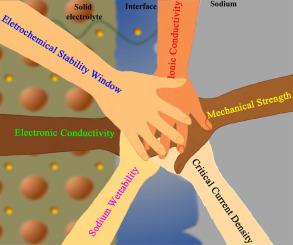当前位置:
X-MOL 学术
›
Mater. Today
›
论文详情
Our official English website, www.x-mol.net, welcomes your feedback! (Note: you will need to create a separate account there.)
Critical interface between inorganic solid-state electrolyte and sodium metal
Materials Today ( IF 24.2 ) Pub Date : 2020-12-01 , DOI: 10.1016/j.mattod.2020.08.016 Bin Tang , Prem Wicram Jaschin , Xin Li , Shou-Hang Bo , Zhen Zhou
Materials Today ( IF 24.2 ) Pub Date : 2020-12-01 , DOI: 10.1016/j.mattod.2020.08.016 Bin Tang , Prem Wicram Jaschin , Xin Li , Shou-Hang Bo , Zhen Zhou

|
Abstract With widening applications in next-generation energy storage systems, rechargeable secondary batteries with enhanced safety and energy density are imperative for technological advancements. All-solid-state sodium batteries can be a promising low-cost and high-energy-density candidate, provided that stable cycling of the energy-dense Na metal anode can be achieved. However, the interface between Na metal and solid-state electrolyte remains a challenging problem. Here we comprehensively review various physical and chemical properties of different types of sodium-based solid-state electrolytes including sodium β-alumina, Na super ionic conductors (NASICON), chalcogenides, perovskites, complex hydrides and antiperovskites, and discuss some critical common factors that affect the Na/electrolyte interface stability. We also summarize the state-of-art strategies to engineer the interface for better electrochemical performances.
中文翻译:

无机固态电解质与金属钠之间的关键界面
摘要 随着下一代储能系统应用的不断扩大,具有更高安全性和能量密度的可充电二次电池对于技术进步势在必行。全固态钠电池可以成为一种有前途的低成本和高能量密度的候选者,前提是可以实现能量密集的 Na 金属负极的稳定循环。然而,Na金属和固态电解质之间的界面仍然是一个具有挑战性的问题。在这里,我们全面回顾了不同类型钠基固态电解质的各种物理和化学性质,包括钠 β-氧化铝、Na 超离子导体 (NASICON)、硫族化物、钙钛矿、复合氢化物和反钙钛矿,并讨论了一些关键的共同因素。影响 Na/电解质界面的稳定性。
更新日期:2020-12-01
中文翻译:

无机固态电解质与金属钠之间的关键界面
摘要 随着下一代储能系统应用的不断扩大,具有更高安全性和能量密度的可充电二次电池对于技术进步势在必行。全固态钠电池可以成为一种有前途的低成本和高能量密度的候选者,前提是可以实现能量密集的 Na 金属负极的稳定循环。然而,Na金属和固态电解质之间的界面仍然是一个具有挑战性的问题。在这里,我们全面回顾了不同类型钠基固态电解质的各种物理和化学性质,包括钠 β-氧化铝、Na 超离子导体 (NASICON)、硫族化物、钙钛矿、复合氢化物和反钙钛矿,并讨论了一些关键的共同因素。影响 Na/电解质界面的稳定性。



























 京公网安备 11010802027423号
京公网安备 11010802027423号